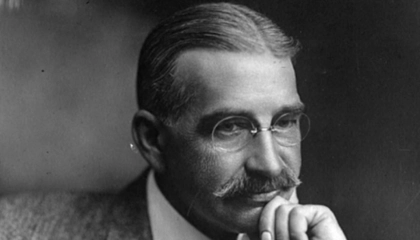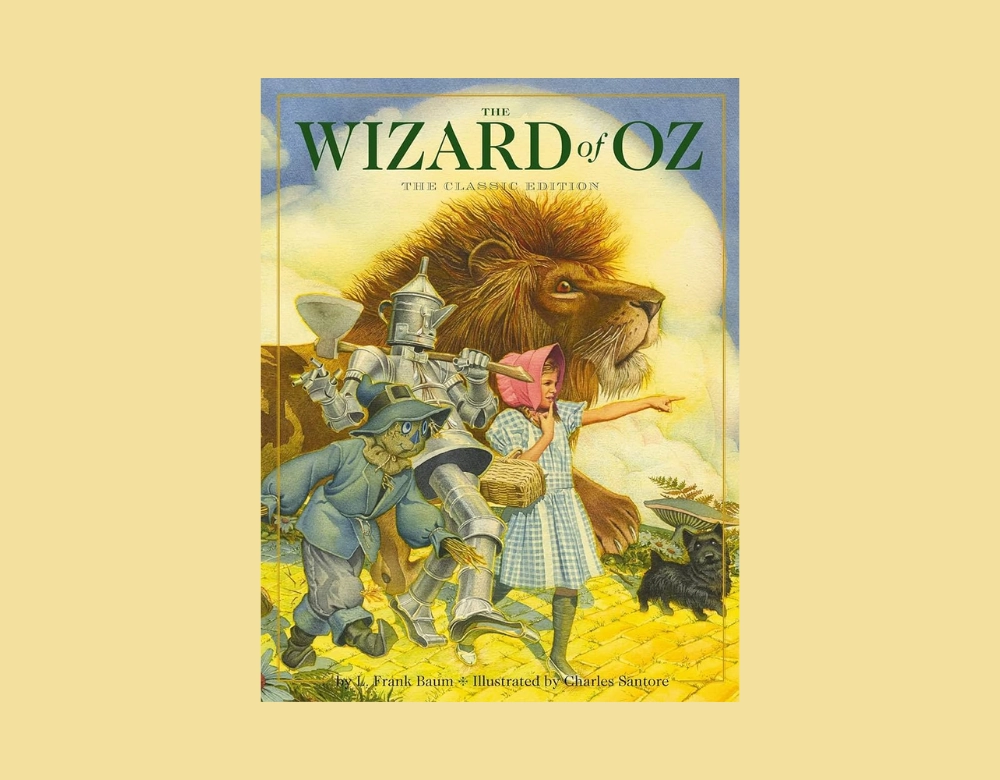L. Frank Baum: The Promoter, The Storyteller, and The American Dreamer
So, L. Frank Baum. This guy was not just a writer, man. Born in 1856, he was a total Renaissance man a failed poultry farmer, a traveling theater manager, a newspaper editor, and a window dresser! His life was a constant, restless search for the American Dream, which he finally found not in a successful business, but in pure imagination. He wrote The Wonderful Wizard of Oz in 1900, right at the turn of the new century, and it was an immediate, huge hit because it was totally unlike the moralizing European fairy tales people were used to.
- The Goal: Baum actually stated he wanted to create a new kind of American fairy tale, one where the magic was totally modern, non-threatening, and totally fun, without all the gruesome moral lessons of the Brothers Grimm. He literally wanted to create happiness.
- Genre: It’s the ultimate American Fantasy/Children’s Literature classic. But critics, decades later, started seeing it as a sly, complex Political Allegory. That’s a huge shift in interpretation.
The Philosophical Engine: The Power of Believing in Yourself
Baum’s core philosophy, at its simplest, is an absolute celebration of self-discovery and the idea that what you seek, you already possess. Dorothy and her friends go on this enormous journey to find brains, heart, and courage, only to realize those qualities were within them all along. The Wizard is literally just a confidence man, an illusionist. That’s a brilliant, optimistic message.
| Core Philosophical Theme | What it Means (The Gist of It) |
| The Myth of the Authority Figure | The Great Wizard of Oz is just a totally regular, slightly incompetent man hiding behind special effects. Baum totally demolishes the idea that powerful people are inherently wise or special. |
| The Inherent Value of the Individual | The Scarecrow, Tin Woodman, and Lion are incomplete, right? But their actions during the journey the Lion’s repeated bravery, the Scarecrow’s clever planning prove they already embody the qualities they seek. The quest is the proof. |
| The Power of Home (Nostos) | Dorothy’s only goal isn’t wealth or magic, but the return to her plain, gray Kansas home. Baum makes the point that the most powerful magic in the world isn’t fantasy; it’s the primal pull of where you belong. |
| The Economic Allegory (The “Secret” Interpretation) | Many scholars argue the book is a covert political critique of the 1890s: Dorothy (the common person), the Yellow Brick Road (the gold standard), the Silver Shoes (the forgotten silver standard), and the Wizard (the corrupt politician). It’s a fun theory, man. |
Required Reading: Why Oz Still Walks the Literary Road

Why University Students Must Study This American Classic
If you’re studying American history, economic allegory, children’s literature, or the foundations of fantasy, L. Frank Baum’s The Wonderful Wizard of Oz is totally essential. It’s a book that defined what American fantasy should look and feel like optimistic, grounded, and focused on self-reliance.
It is absolutely crucial for students because:
- Archetypal Journey: It’s a perfect, simple example of the “Hero’s Journey.” Analyzing Dorothy’s trip, the allies she gains, and the tests she overcomes is a foundational lesson in narrative structure for any writer or critic.
- Allegorical Debate: The political allegory theory (the Silver Shoes, the Emerald City as greenback currency) forces students to think critically about how texts can carry hidden, contextual meanings, even when written as pure fantasy.
- Cultural Impact: The sheer weight of its influence on American culture (from film to theme parks to political rhetoric) makes it necessary to understand the original source material.
What to Read Next: Further Deep Dives into American Fantasy and Innocence
Once you’ve walked the Yellow Brick Road, you’ll probably want to explore other works that share Baum’s unique blend of the fantastic and the grounded, American experience.
| Recommended Reading | The Direct Connection to Baum’s Themes |
| Ozma of Oz (L. Frank Baum) | One of the direct sequels. The Oz books were unique in that Baum established Oz as a literal, ongoing place. Reading the sequels shows how he developed the world and its complex politics (like the land of the Nome King). |
| Alice’s Adventures in Wonderland (Lewis Carroll) | The great European fantasy that came before Oz. Alice’s journey is chaotic and philosophical, whereas Dorothy’s is grounded and moral. Reading them together provides a perfect contrast in national fantasy styles. |
| The Secret Garden (Frances Hodgson Burnett) | Another classic children’s book from the era. It focuses on the transformative power of finding one’s inner value and creating a safe, magical place (the garden) through positive human connection, echoing the theme of self-worth. |
When a Book Becomes a Legend: Oz’s Stage Life
The Cinematic Explosion of the Emerald City
The influence of The Wizard of Oz on film and drama is, like, a total cultural explosion, man. While Baum’s book is great, the 1939 film totally cemented the story’s visual and musical status as an American myth. The story is pure cinematic gold because it transitions from the stark, gray reality of Kansas to the dazzling, terrifying colors of Oz.
It permanently established the visual trope of the dream journey and the dramatic use of color to signify the boundary between reality and fantasy.
- On Direction: The shift from black and white (Kansas) to Technicolor (Oz) in the 1939 film is one of the most famous directorial choices in film history. It wasn’t just aesthetic; it was totally symbolic of Dorothy’s emotional awakening.
- Performance: The characters are absolutely iconic. The Cowardly Lion, the Witch, the Munchkins they all demand highly theatrical, over-the-top, yet deeply emotional performances.
Key Adaptations: Oz Across Media
The story’s simple plot but complex characters means it’s constantly being reinvented, always finding new ways to tell the old tale.
| Adaptation Type | Key Example/Details | Why It’s Famous/Relevant |
| The 1939 MGM Film | Starring Judy Garland. The definitive version; a permanent cultural touchstone. | Its songs (“Over the Rainbow”) are anthems, and the characters are absolute cultural shorthand for lacking essential human traits (heart, brain, courage). |
| The Stage Musical Wicked (2003) | Tells the backstory of the Wicked Witch of the West and Glinda. A massive Broadway hit. | Proves the text’s enduring power to be reinterpreted and humanized; it takes the villain and makes her a sympathetic character, showing the deep potential for revisionist critique. |
| The Wiz (1974) | An African-American retelling of the story (adapted into a 1978 film with Diana Ross). | Showed the story’s total universality; the core quest for identity and home translates perfectly across different cultural and social landscapes. |
Final Thoughts: The Unbreakable Magic of the Ruby Slippers
So, we finish our magical flight through L. Frank Baum’s The Wonderful Wizard of Oz. Why does this simple tale of a Kansas girl and her dog still resonate so profoundly globally? Because it provides the most comforting, optimistic truth in the American experience: Magic is real, but it lives inside you.
- Baum permanently showed us that the terrifying journey to find your greatest needs (courage, intellect) is what ultimately proves you already possess them. The power was in the shoes all along, man.
- The book’s final, beautiful message is that we don’t need a powerful authority figure (the Wizard) to grant us what we need; we just need the courage to ask and the will to act.
It is a permanent, essential reminder that there’s no place like home, especially the home within your own heart.

